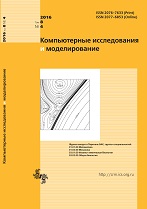|
This article is cited in 2 scientific papers (total in 2 papers)
MODELS IN PHYSICS AND TECHNOLOGY
Buckling problems of thin elastic shells
V. A. Grachev, Yu. S. Nayshtut
Academy of Building and Architecture
Samara State Technical University,
194 Molodogvardeiskaya st., Samara, 443001, Russia
Abstract:
The article covers several mathematical problems relating to elastic stability of thin shells in view of inconsistencies that have been recently identified between the experimental data and the predictions based on the shallow-shell theory. It is highlighted that the contradictions were caused by new algorithms that enabled updating the values of the so called “low critical stresses” calculated in the 20th century and adopted as a buckling criterion for thin shallow shells by technical standards. The new calculations often find the low critical stress close to zero. Therefore, the low critical stress cannot be used as a safety factor for the buckling analysis of the thin-walled structure, and the equations of the shallow-shell theory need to be replaced with other differential equations. The new theory also requires a buckling criterion ensuring the match between calculations and experimental data.
The article demonstrates that the contradiction with the new experiments can be resolved within the dynamic nonlinear three-dimensional theory of elasticity. The stress when bifurcation of dynamic modes occurs shall be taken as a buckling criterion. The nonlinear form of original equations causes solitary (solitonic) waves that match non-smooth displacements (patterns, dents) of the shells. It is essential that the solitons make an impact at all stages of loading and significantly increase closer to bifurcation. The solitonic solutions are illustrated based on the thin cylindrical momentless shell when its three-dimensional volume is simulated with two-dimensional surface of the set thickness. It is noted that the pattern-generating waves can be detected (and their amplitudes can be identified) with acoustic or electromagnetic devices.
Thus, it is technically possible to reduce the risk of failure of the thin shells by monitoring the shape of the surface with acoustic devices. The article concludes with a setting of the mathematical problems requiring the solution for the reliable numerical assessment of the buckling criterion for thin elastic shells.
Keywords:
elastic shells, buckling, three-dimensional non-linear theory of elasticity, patterns and dents, acoustic devices.
Received: 11.05.2018
Revised: 27.08.2018
Accepted: 11.09.2018
Citation:
V. A. Grachev, Yu. S. Nayshtut, “Buckling problems of thin elastic shells”, Computer Research and Modeling, 10:6 (2018), 775–787
Linking options:
https://www.mathnet.ru/eng/crm684 https://www.mathnet.ru/eng/crm/v10/i6/p775
|

| Statistics & downloads: |
| Abstract page: | 207 | | Full-text PDF : | 98 | | References: | 30 |
|




 Contact us:
Contact us: Terms of Use
Terms of Use
 Registration to the website
Registration to the website Logotypes
Logotypes









 Citation in format
Citation in format 